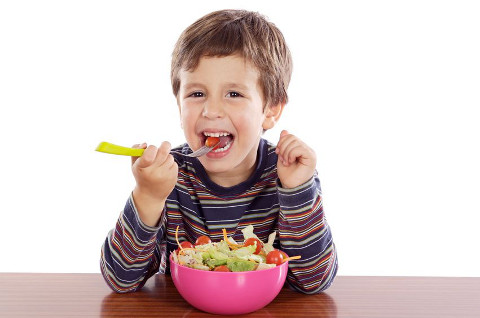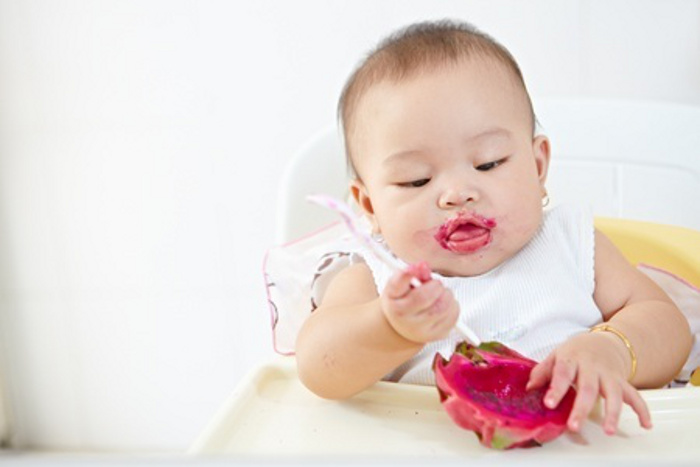1. Introduce vegetables to your children when they are young

Most children do not like vegetables because of their taste and texture. However, there are many ways to encourage kids to eat different vegetables. Early introduction of vegetables into the child’s diet is helpful so that the child gets accustomed to the taste. If the child dislikes a particular vegetable, a more gradual and subtle approach is to blend or hide the vegetable with other foods that he likes, such as tiny pieces in fried rice or vegetable and fruit smoothies. Mix the vegetables with foods or textures that the child prefers, for example, baked broccoli with cheese and French beans coated with breadcrumbs to imitate fries.
Involve the child in food preparation, such as grocery shopping and making sushi rolls with cucumber and tuna. Parents should also be role-models themselves and show their child that eating vegetables can be both healthy and enjoyable.
2. Introduce these foods for optimal growth and development
- Milk and dairy products
- Yogurt and cheese
- Eggs
- Blueberries
- Tomato
- Dark green leafy vegetables
- Nuts and seeds
- Fish
- Cocoa
Refer to the article Top 10 Healthy Foods For Your Growing Child for more details.
3. Expose them to a variety of foods

Getting children to eat everything allows them to be exposed to a wide variety of tastes and textures. In this way, they are less likely to develop strong or extreme preferences or dislikes towards certain foods as they are constantly having different flavours in their diets, which keep them interested and curious during mealtimes.
4. Your attitude towards food shape your child’s eating behaviour
Children have innate preferences and dislikes towards different tastes. As infants, they prefer sweet-tasting foods and dislike bitter foods such as certain vegetables. This can be an evolutionary developmental response as sweet tastes signalled foods with higher sugars or calories, while bitter taste signalled foods that might be toxic. Your attitude towards their picky eating behaviour can also reinforce his food preferences.
Restricting highly palatable foods from the child’s diet might backfire and only increase the desire for it; likewise, pressurizing the child to eat healthy but less tasty foods would only aggravate the dislike for them. If you too are a picky eater, the child will likely follow your behaviour and start having strong preferences or dislikes for certain foods.
5. Be a role model

The best way is for you to learn to eat healthy foods. Children learn the most from observing the behaviour of their parents. It is extremely important for you to be the role models for their children. You can involve their child in finding interesting recipes and cooking and tasting the foods together as part of bonding with your children.
6. Foods should not be used as treats and rewards for children
This might reinforce their food preferences and picky eating behaviour by making such unhealthy foods more desirable than ever. Giving unhealthy foods as treats can also encourage more snacking in between regular meals and promote excessive calorie consumption and weight gain. You can have other alternative methods of reinforcing good behaviour for their child, such as collecting stickers to exchange for a toy, playing their favourite game together, or an extra 10 minutes at the playground.
If you are interested to get your child started on a vegetarian diet…
There are various degrees of vegetarianism, but nevertheless, it is important to guard against nutritional deficiencies depending on what foods are omitted from the child’s diet. If milk products are removed from the diet, then the child might not be consuming adequate calcium and Vitamin D, which are important for maintaining strong bones and teeth. Hence alternative sources of calcium must be provided, such as calcium-fortified soy milk, tofu, soybeans and soynuts, broccoli, bok choy, Chinese cabbage and kale.
Vegetarian diet might also not provide adequate protein sources or a good balance of all the essential amino acids for the growing child. As a general guideline, the protein intake should come from more than one source. For example, combining cereal products such as wheat or rice with legumes (beans, peas) provides a higher quality mixture of amino acids than if either is consumed alone. Because of the lack of meat products, consumption of certain important nutrients such as iron, Vitamin B12, and zinc might not be sufficient. Therefore, it is important to serve the child commercially prepared foods fortified with these nutrients, such as fortified cereals, or consider supplements after discussing with your doctor.
Plant-based sources of iron include dried beans and dark green leafy vegetables like spinach. Iron absorption is also markedly increased by eating foods containing Vitamin C along with foods containing iron.
This article is contributed by Dr Chu Hui Ping, Specialist in Paediatric Medicine & Consultant, Raffles Children’s Centre.
* * * * *
Like what you see here? Get parenting tips and stories straight to your inbox! Join our mailing list here.
Want to be heard 👂 and seen 👀 by over 100,000 parents in Singapore? We can help! Leave your contact here and we’ll be in touch.
























































Leave a Comment: